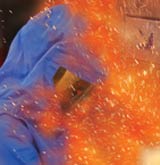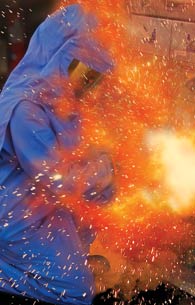
Making the Grade
Updates at Bowater Inc.'s newsprint plant at Grenada, Miss., have strengthened workers' protection against arc flash while easing heat stress concerns.
- By Mike Longman
- Jul 01, 2007
 IN 2005, Bowater Inc., a leading producer
of coated and specialty papers and
newsprint, stood by its commitment to
ensure the safety of its workers at a
Grenada, Miss. facility that is Mississippi’s
only newsprint manufacturer. Bowater
looked to our Electrical Services and Systems
district office in Pelham, Ala. to
implement its arc flash training, perform an
Arc Flash Hazard Analysis to assess its
safety needs and concerns, and to coordinate
its power systems.
IN 2005, Bowater Inc., a leading producer
of coated and specialty papers and
newsprint, stood by its commitment to
ensure the safety of its workers at a
Grenada, Miss. facility that is Mississippi’s
only newsprint manufacturer. Bowater
looked to our Electrical Services and Systems
district office in Pelham, Ala. to
implement its arc flash training, perform an
Arc Flash Hazard Analysis to assess its
safety needs and concerns, and to coordinate
its power systems.
An arc flash is produced by a flow of
electrical current through ionized air after
an initial flashover or short circuit. An arc
flash event releases a tremendous amount
of energy in the form of thermal heat, toxic
fumes, pressure waves, blinding light,
sound waves, and explosions that can result
in serious injuries that include critical
burns, collapsed lungs, loss of vision,
ruptured eardrums, and puncture
wounds. Some are fatal.
Accidents, unintentional contact
with electrical systems,
equipment failure, improperly
designed equipment, and/or
work procedures can cause an arc
flash explosion. According to the
National Fire Protection Association,
an arc flash occurs “when
an electric current passes through
air between ungrounded conductors
or between ungrounded conductors and
grounded conductors.” NFPA 70E, Standard
for Electrical Safety in the Workplace,
sets forth basic requirements for electrical
safety at work sites and requirements for arc
flash hazards, in particular.
BOWATER’S NAME
CHANGING, TOO
Bowater is merging with Abitibi-Consolidated
Inc., another large newsprint
supplier, in what the companies call a
“merger of equals.” The resulting company,
AbitibiBowater, will be the third largest
public paper and forest products
company in the United States and the
eighth largest in the world.
The company’s headquarters and
executive offices will be located in Montreal,
Canada. U.S. regiona manufacturing
and sales offices will be in
Greenville, S.C. |
An arc flash releases dangerous levels of
radiant heat energy that can cause fatal or
severe burns. Fatal burns can occur to
workers up to 5 feet or more from the arc,
and severe burns can happen up to 10 feet
away during a high-energy arc flash. An arc
flash produces some of the highest temperatures
on earth—up to 35,000 degrees
Fahrenheit. These excessive temperatures
cause the air and metal in the path of the arc
to expand and explode, creating an arc blast.
Protective Clothing Strikes a Balance
Based upon the initial systems study findings,
Bowater and our team devised a
strategy to reduce arc flash danger significantly
at the Grenada facility. Bowater
immediately called upon our power systems
expertise to coordinate its existing electrical
protective measures, devices, and monitoring,
as well as conduct the arc flash
analysis. An integrated systems approach for
Bowater served to identify potential arc flash
hazard areas within the electrical system and
offer a variety of possible solutions.
Employee safety was the primary concern
of Gary Fant, Bowater’s maintenance
manager. Because of generally hot and
humid conditions at the facility, Fant
wanted to create an environment in which
the employees could wear sufficient personal
protective clothing to prevent the
potentially fatal or severe effects of arc
flash, yet not so much that employees
would be exposed to the danger of
extreme heat stress.
Installation of new switch units offered
the primary line of defense. These innovative
protective devices, installed in the
company’s power circuit breakers, lower
arc flash incident energy levels by temporarily
lowering trip settings while
workers are performing work on the energized
electrical system.
Bowater’s commitment to employee
safety and arc flash incident prevention
was emblematic of its historical efforts to
prevent workplace accidents. The company’s meticulous recordkeeping and data
collection removed a major hurdle faced
with many industrial clients; implementation
could be expedited because Bowater
had helped lay the groundwork. Still, there
were several key challenges during the
safety solutions implementation.
No Downtime Allowed
Bowater, one of the world’s largest
newsprint producers, could not afford
lengthy downtime. This led to a tight timeframe
to upgrade and install the units onto
the company’s circuit breakers. Bowater’s
production schedule allowed only a threeday
window for operation shutdown,
during which the retrofitting and testing of
96 circuit breakers in almost 30 locations
had to take place, while simultaneously
performing testing and maintenance at all
levels of the power system.
Several workstations were set up to
retrofit the units onto the circuit breakers
and test them. Switchgear specialists were
brought in from Alabama and Louisiana to
oversee the project. In the meantime, additional,
specific information was being collected
about the connected loads and operating
parameters for each breaker, and an
on-site system study was under way to
verify proper settings for each individual
breaker. While the installation took place,
key parts of the Bowater mill remained
open and functional so other necessary
maintenance work could be done.
The work was completed in June 2006,
resulting in a state-of-the-art safety system
and maximum peace of mind for electrical
maintenance employees and managers.
Heat Stress Concerns Eased
By installing the units, Bowater was able to
offer its electrical workers three key safetyand
reliability-related benefits:
1. The change lowered arc flash incident
energy levels in work locations.
2. Less arc flash PPE is required, which
reduces heat stress. For example, MCC 51-
05 before the retrofit was a category 3 arc
flash hazard at 8.3 cal/cm2, requiring a
flame resistant (FR) shirt and pants, plus
FR coveralls over them. After the retrofit,
MCC 51-05 was reduced to a category 1
arc flash hazard at 1.9 cal/cm2, requiring
only an FR shirt and pants.
3. For system reliability, replacing the
older analog breaker trip units with microprocessor-
based true RMS trip units gives
more flexibility to the power systems engineer
in making settings for system coordination.
Also, the true RMS units are less
susceptible to nuisance tripping from harmonic
signals on the line generated by
Bowater’s paper mill drives.
Bowater is currently implementing an
electrical safety program that includes all
aspects of NFPA 70E. It is implementing
procedures to take the arc flash safety
improvements within its electrical system a
step beyond. As the company develops and
implements its ongoing electrical safety
program, informational sharing sessions
will increase employees’ awareness of their
evolving role in the overall safety program.
With a safety initiative of this magnitude,
there is no downtime.
This article originally appeared in the July 2007 issue of Occupational Health & Safety.